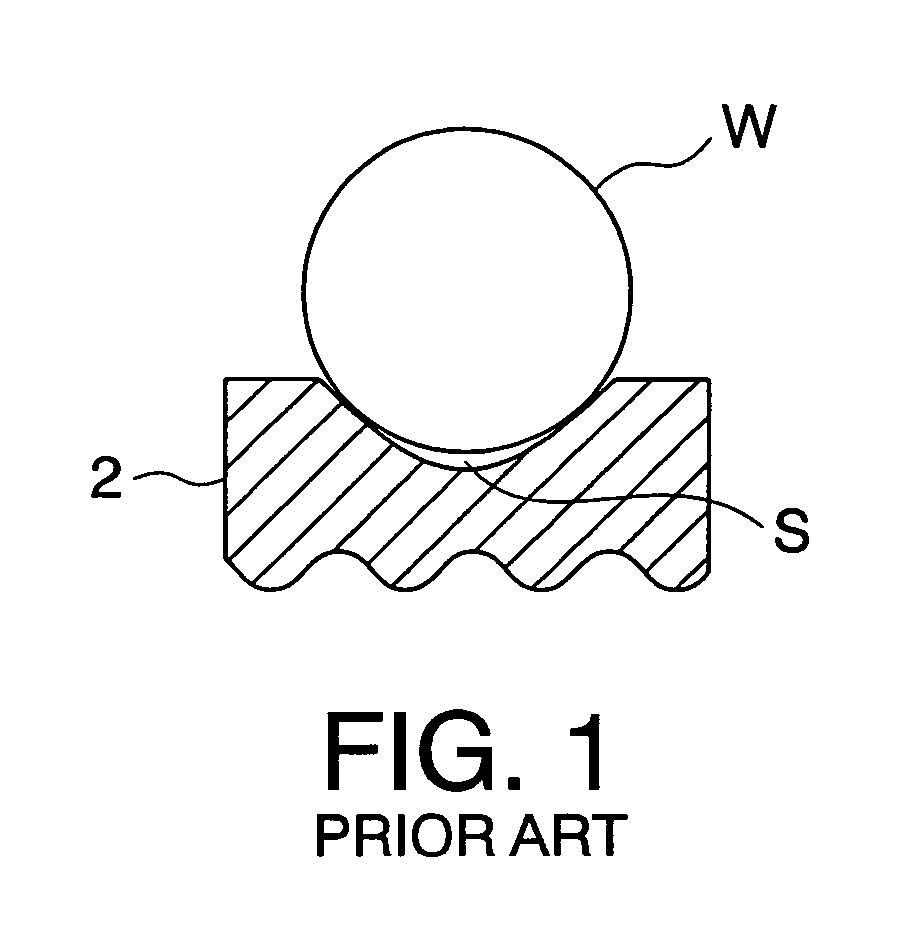Apparatus and method for producing a glass optical element and glass optical element produced thereby
a technology of glass optical elements and apparatuses, which is applied in glass tempering apparatuses, glass making apparatuses, manufacturing tools, etc., can solve the problems of gas escaping from the space, the above-mentioned methods are disadvantageous, and the optical performance and surface quality of the optical element obtained by press-forming are adversely affected, so as to achieve efficient heat and heat soak the glass material
- Summary
- Abstract
- Description
- Claims
- Application Information
AI Technical Summary
Benefits of technology
Problems solved by technology
Method used
Image
Examples
first example
[0095] Description will be made of a first example using the apparatus illustrated in FIG. 2.
[0096]FIG. 3 shows a press schedule in the first example.
[0097] In this example, the glass material W had a spherical shape and was produced by polishing an optical glass material having nd=1.69350, vd=53.20, a sagging point of 560° C., and a transition point of 520° C. into a diameter of 2.7 mm.
[0098] The glass material W was placed on the forming surface of the lower die 2. The forming surface had a paraxial radius of curvature of 1.1 mm. Next, the upper die 1 and the sleeve 3 were set. The space S was formed between the lower die 2 and the glass material W. The maximum height of the space S at the center was 75 μm. In FIG. 2, the size of the space S is emphasized for convenience of illustration.
[0099] A contacting portion at which the lower die 2 and the glass material W were contacted with each other had a diameter of 2.2 mm. The optical element (lens) after press-forming had an oute...
second example
[0114] Hereinafter, description will be made of a second example using the apparatus illustrated in FIG. 4.
[0115]FIG. 5 shows a press schedule in the second example.
[0116] The species of the glass material and the shapes of the optical element (lens) and the forming mold are same as those in the first example.
[0117] A pressing process in the second example is as follows.
[0118] Using a die assembling / disassembling unit (not shown), the glass material W was placed on the lower die 2. Next, the upper die 1 was inserted into the sleeve 3. The forming mold comprising the upper and the lower dies 1 and 2 was put on a die support 17 and loaded into the preliminary chamber (not shown) adjacent to the heating furnace chamber 101b. After evacuation, the nitrogen gas was introduced into the preliminary chamber to perform gas exchange. After completion of gas exchange into the nitrogen gas, the shutter 112 was opened. The forming mold together with the die support 17 was transferred into th...
PUM
| Property | Measurement | Unit |
|---|---|---|
| glass viscosity | aaaaa | aaaaa |
| glass viscosity | aaaaa | aaaaa |
| diameter | aaaaa | aaaaa |
Abstract
Description
Claims
Application Information
 Login to View More
Login to View More - R&D
- Intellectual Property
- Life Sciences
- Materials
- Tech Scout
- Unparalleled Data Quality
- Higher Quality Content
- 60% Fewer Hallucinations
Browse by: Latest US Patents, China's latest patents, Technical Efficacy Thesaurus, Application Domain, Technology Topic, Popular Technical Reports.
© 2025 PatSnap. All rights reserved.Legal|Privacy policy|Modern Slavery Act Transparency Statement|Sitemap|About US| Contact US: help@patsnap.com



